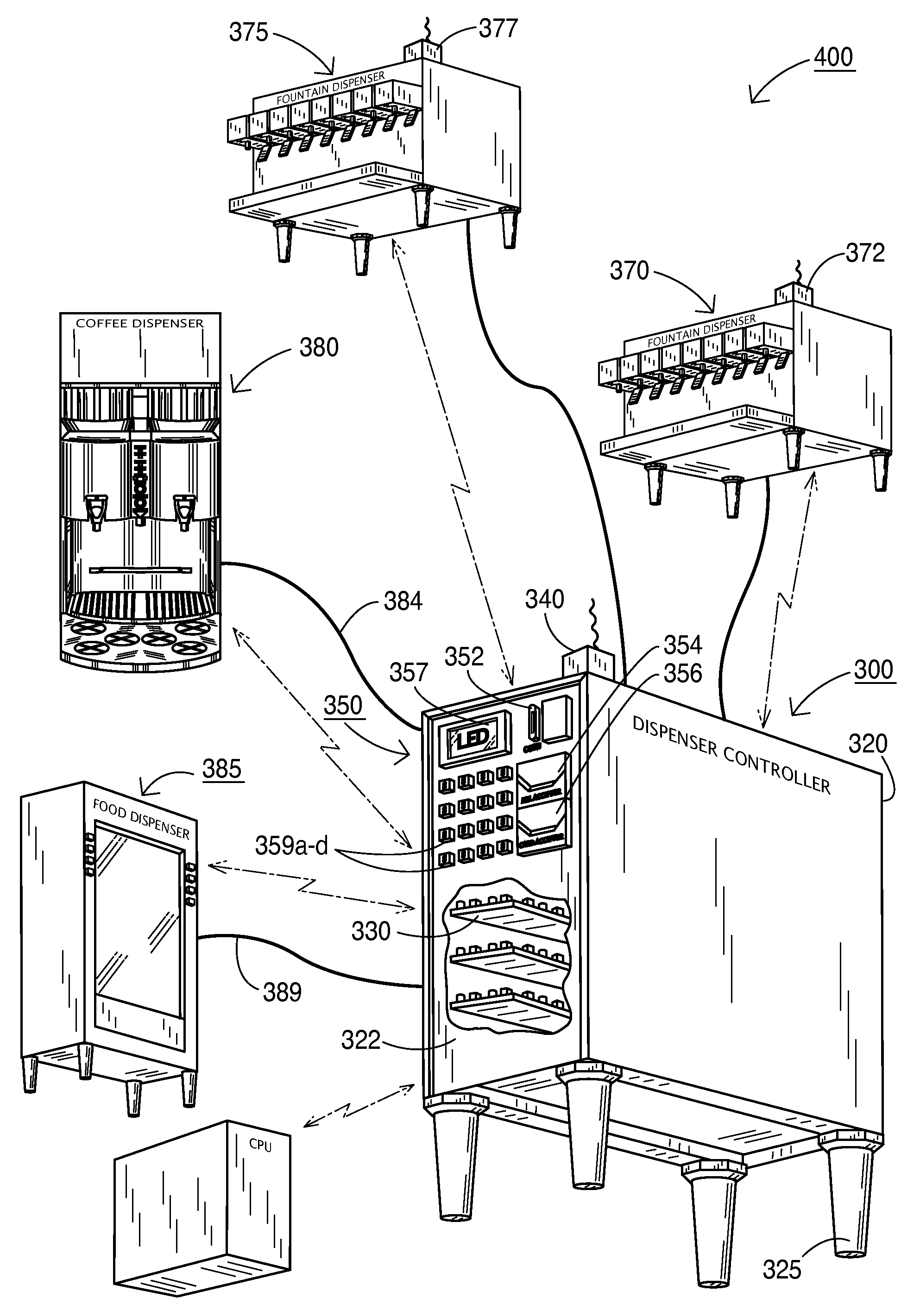Dispenser control system
- Summary
- Abstract
- Description
- Claims
- Application Information
AI Technical Summary
Benefits of technology
Problems solved by technology
Method used
Image
Examples
example one
[0024]The four buttons 159a-d are configured for vending price / product size selection by a retail store clerk, for example. For instance, the buttons 159a-d may be programmed to represent $0.50 (small), $1.00 (medium), $1.50 (large), and $2.00 (extra large). Another row of buttons (not shown) might be used to select the type of beverage, and a third row of buttons might select prescribed vending machines in a network (FIG. 2). Upon receipt of payment from a customer for a selected size beverage, the store clerk selects the size to be dispensed by depressing the appropriate button(s). Alternatively, buttons 159 may be keys, or a keyboard. Upon selecting / authorizing the size and type of beverage to be dispensed, the control circuitry generates an appropriate signal either through a hardwired connection to the selected dispenser or via a wireless transmitter 140 to the wireless receiver 240 of the dispenser 220. The received signal is processed by the control circuitry 230 of the dispe...
example two
[0025]Again, four buttons 159a-d are configured exclusively for vending price. For instance, the buttons 159a-d may be programmed to represent $0.50, $1.00, $1.50, and $2.00. As in Example One, another row of buttons (not shown) might be used to select the type of beverage, and a third row of buttons might select prescribed vending machines in a network (FIG. 2). In the case of beverages, these prices may represent different sizes of beverages (small, medium, large, extra large). The difference here is that the customer selects a size by depressing the appropriate button(s) and inserting the chosen form of payment in the coin acceptor 154, bill acceptor 156, or card acceptor 156. The LED display 157 then either displays the total entered or the selected price, depending upon the programming of the LED display 157. From there on the operation is the same as in Example One.
example three
[0026]Two of the four buttons are configured for product selection and two are programmed for vending price. For instance in FIG. 2, buttons 159a and 159b might be programmed for regular coffee and decaffeinated coffee respectively. Again, another row of buttons (not shown) might be used to select the condiments, and a fourth row of buttons might select prescribed vending machines in a network (FIG. 2). Button 159c and 159d may be programmed to represent $1.00 and $2.00 respectively. In the case of coffee, these prices represent medium and large cups of coffee, for example. Thus, the consumer selects both a coffee type and size by depressing the appropriate buttons and inserting the chosen form of payment in the coin acceptor 352, bill acceptor 354, or card acceptor 356. Again, the signal is transmitted via the wireless transmitter 340 to the wireless receiver 372, 377 of the dispenser 370, 375. The control circuitry of the dispenser activates all of the solenoids for the selected c...
PUM
 Login to View More
Login to View More Abstract
Description
Claims
Application Information
 Login to View More
Login to View More - R&D
- Intellectual Property
- Life Sciences
- Materials
- Tech Scout
- Unparalleled Data Quality
- Higher Quality Content
- 60% Fewer Hallucinations
Browse by: Latest US Patents, China's latest patents, Technical Efficacy Thesaurus, Application Domain, Technology Topic, Popular Technical Reports.
© 2025 PatSnap. All rights reserved.Legal|Privacy policy|Modern Slavery Act Transparency Statement|Sitemap|About US| Contact US: help@patsnap.com



